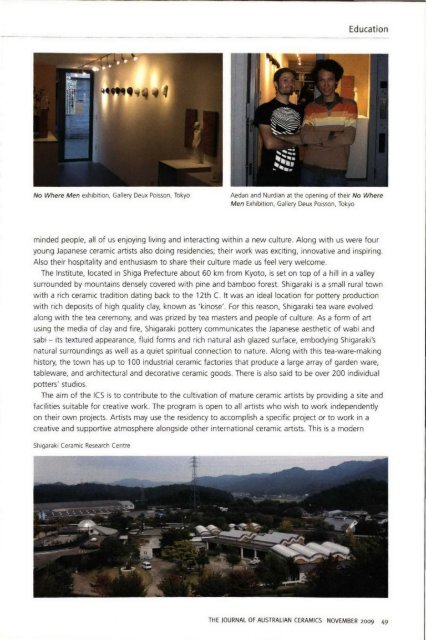The Journal of Australian Ceramics Vol 48 No 3 November 2009
Create successful ePaper yourself
Turn your PDF publications into a flip-book with our unique Google optimized e-Paper software.
Education<br />
<strong>No</strong> Where M en exhibition, Gallery Deux Poisson, Tokyo<br />
Aedan and Nurdian at the opening <strong>of</strong> their <strong>No</strong> Where<br />
M en Exhibition, Gallery Deux Poisson, Tokyo<br />
minded people, all <strong>of</strong> us enjoying living and interacting within a new culture. Along with us were four<br />
young Japanese ceramic artists also doing residencies; their work was exciting, innovative and inspiring.<br />
Also their hospitality and enthusiasm to share their culture made us feel very welcome.<br />
<strong>The</strong> Institute, located in Shiga Prefecture about 60 km from Kyoto, is set on top <strong>of</strong> a hill in a valley<br />
surrounded by mountains densely covered with pine and bamboo forest. Shigaraki is a small rural town<br />
w ith a rich ceramic tradition dating back to the 12th C. It was an ideal location for pottery production<br />
w ith rich deposits <strong>of</strong> high quality clay, known as 'kinose'. For this reason, Shigaraki tea ware evolved<br />
along w ith the tea ceremony, and was prized by tea masters and people <strong>of</strong> culture. As a form <strong>of</strong> art<br />
using the media <strong>of</strong> clay and fire, Shigaraki pottery communicates the Japanese aesthetic <strong>of</strong> wabi and<br />
sabi - its textured appearance, fluid forms and rich natural ash glazed surface, embodying Shigaraki's<br />
natural su rroundings as well as a quiet spiritual connection to nature. Along with this tea-ware-making<br />
history, the town has up to 100 industrial ceramic factories that produce a large array <strong>of</strong> garden ware,<br />
tableware, and architectural and decorative ceramic goods. <strong>The</strong>re is also said to be over 200 individual<br />
potters' studios.<br />
<strong>The</strong> aim <strong>of</strong> the ICS is to contribute to the cultivation <strong>of</strong> mature ceramic artists by providing a site and<br />
facilities suitable for creative work. <strong>The</strong> program is open to all artists who wish to work independently<br />
on their own projects. Artists may use the residency to accomplish a specific project or to work in a<br />
creative and supportive atmosphere alongside other international ceramic artists. This is a modern<br />
Shigaraki Ceramic Research Centre<br />
THE 10URNAl OF AUSTRALIAN CERAMICS NOVEMBER <strong>2009</strong> 49


















